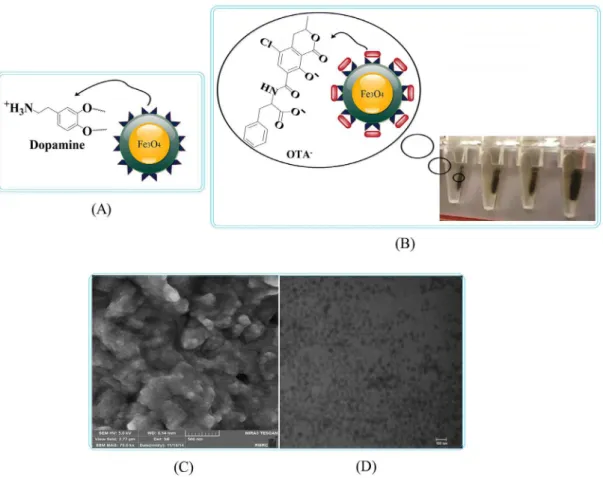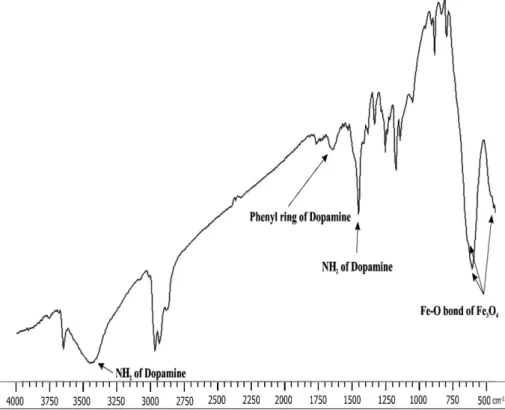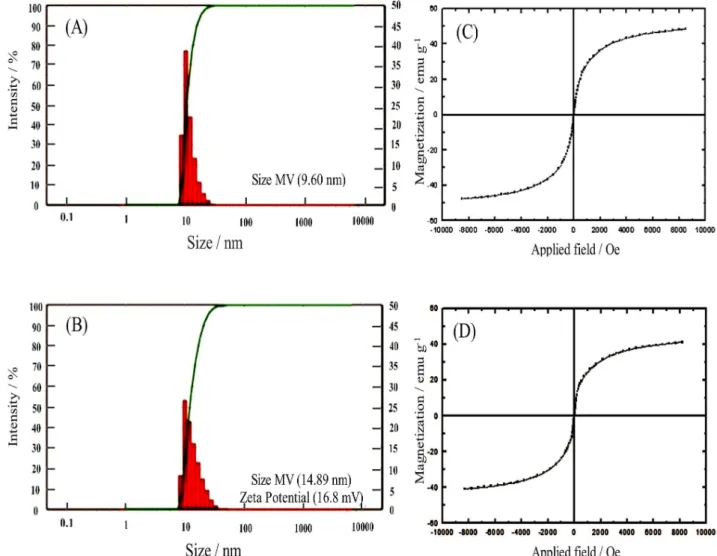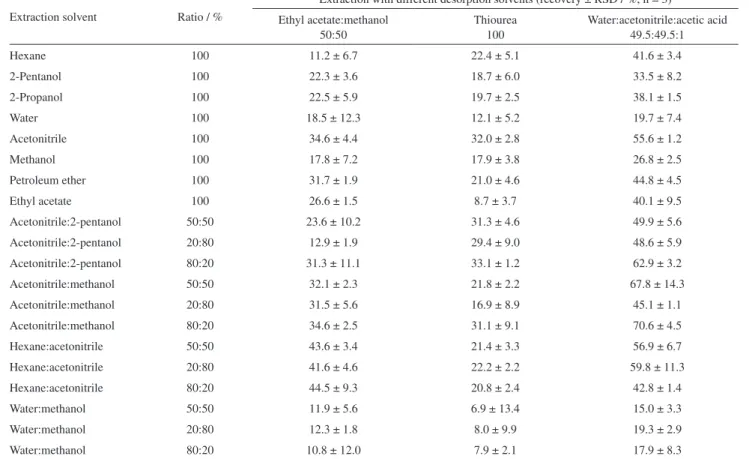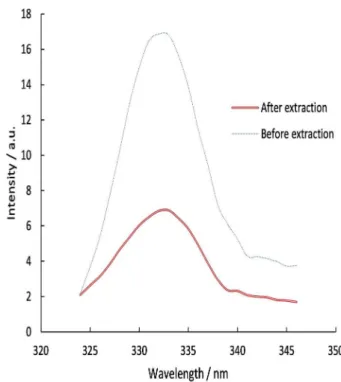Article
Printed in Brazil - ©2017 Sociedade Brasileira de Química0103 - 5053 $6.00+0.00
*e-mail: mostafamajd@live.com, mhmajd@zbmu.ac.ir
A Simple and Fast Method for Magnetic Solid Phase Extraction of Ochratoxin A
Azam Sargazi,a Amin Aliabadi,a,b Ali Rahdari,a,b Samin Allahdini-Hesaroiyeh,a,b
Massoud Nejati-Yazdinejad c and Mostafa Heidari Majd*,a
aFaculty of Pharmacy and bStudent Research Committee, Zabol University of Medical Sciences, Zabol, Iran
cDepartment of Chemistry, Faculty of Sciences, University of Zabol, Zabol, Iran
We report on the synthesis of dopamine loaded magnetic nanoparticles (MNPs) for new, simple, fast and repeatable extraction of ochratoxin A from different solvents and milk without utilizing immunoaffinity columns and even high-tech devices. To this end, Fe3O4 nanoparticles (NPs) were synthesized using thermal decomposition reaction and dopamine (DPA) was then conjugated with Fe3O4 nanoparticles (NPs) to form Fe3O4-DPA NPs. Dynamic light scattering, field emission scanning electron microscopy and transmission electron microscopy revealed an average size of about 15 nm for Fe3O4-DPA NPs. Moreover, zeta potential measurement and vibrating sample magnetometer confirmed positively charged (16.8 mV) and superparamagnetic behavior of MNPs, which are effective factors for a good adsorbent in the extraction. Various solvents and different effective parameters were measured until acetonitrile:methanol was selected as the best extraction solvent. In addition, based on the pH-partition theory, with changes in pH, we were able to increase and enhance the extraction rate to 94%. Moreover, the ability of Fe3O4-DPA NPs in solid phase extraction of ochratoxin A from spiked milk was evaluated. The recovery rate for extraction of OTA from milk was 68%.
Keywords: ochratoxin A, magnetic nanoparticles, HPLC, solid phase extraction, fluorescence spectroscopy
Introduction
Mycotoxins are secondary fungal metabolites that can contaminate agricultural commodities and animal feeds.1 In great variety of foods, some species of Aspergillus fungi produce a carcinogenic metabolite called ochratoxin A (OTA).2
Ochratoxin A is a stable molecule that resists degradation in acidic conditions, food processing and also blood serum with 35 days half-life. It can cause nephrotoxic, hepatotoxic, neurotoxic, teratogenic and immunotoxic diseases in humans.1-4 Several methods for laboratory analysis and detection of ochratoxin A in food samples such as thin layer chromatography (TLC), high-performance liquid chromatography (HPLC), gas chromatography-mass spectrometry (GC-MS), fluorescence polarization immunoassays, capillary electrophoresis (CE), enzyme-linked immunosorbent assay (ELISA) and fluorescent and surface plasmon resonance immunosensors have been reported.1,2,5 The most frequently used method for the
determination of OTA in grains and many other foodstuffs is extraction and clean up via immunoaffinity column (IAC) before employing the HPLC.6-8 In all validated methods for the detection of OTA based on IAC, solvents were utilized for extraction of OTA from real samples. Thereafter, these solvents were passed through the immunoaffinity column containing antibodies specific for OTA.9 However, this method has some disadvantages which reduce its efficiency; the contamination of immunoaffinity columns with the ethyl ester of ochratoxin A is one of such disadvantages.7 Accordingly, we intend to use magnetic solid phase extraction (MSPE) as an alternative for IAC. So, it is necessary to find suitable solvents for extraction and also determine the ability of magnetic nanoparticles to provide acceptable interaction with OTA.
are the best choice for adsorption of OTA on their modified surface.6,13 Low toxicity, simple preparation and low price are some of the benefits of MNPs which guarantee high extraction efficiency. Moreover, reuse of MNPs is another advantage for MSPE method, because reused immunoaffinity columns give some problems for analysis.7 Nevertheless, unmodified MNPs have high tendency to agglomerate due to their high surface energy, but MNPs can be grafted with functional groups for further stability in fluids.14
Dopamine (DPA) as an anchoring agent could modify the surface of MNPs15 and provide so much stability for MNPs with amine-end terminated surface.16 In the present study, for the first time, dopamine loaded MNPs were used as electrostatic sorbents in magnetic solid phase extraction to separate ochratoxin A from different solvents and milk without utilizing immunoaffinity columns and even high-tech devices.
Experimental
Materials
Iron(III) acetylacetonate [Fe(acac)3], benzyl ether,
triethylamine and standard solution of ochratoxin A (OTA) was purchased from Merck (Hohenbrunn, Germany). Oleylamine and dopamine hydrobromide (DPA) was supplied from Sigma-Aldrich (Steinheim, Germany). All HPLC grade and analytical grade solvents were delivered from Merck (Gernsheim, Germany).
Synthesis of Fe3O4-DPA magnetic nanoparticles
Fe3O4 magnetic nanoparticles were synthesized via thermal decomposition reaction as described previously.17,18 In the next step, Fe3O4 (0.2 g, 0.86 mmol) was dispersed in 8 mL dichloromethane. Dopamine hydrobromide (0.5 g, 2.14 mmol) was added to the solution and stirred overnight under argon blanket at 25 °C. Thereafter, solutions were sonicated for 15 min and Fe3O4-DPA (Figure 1A) was precipitated utilizing hexane. The yield was 86.5%.
Characterization of modified Fe3O4
The surface modifications of MNPs were validated by Fourier transform infrared spectroscopy (FTIR) using Shimadzu IR PRESTIGE 21 spectrophotometer (Shimadzu
Figure 1. Schematic modification, separation ability, morphology and size of the engineered MNPs. (A) Dopamine conjugated MNPs; (B) successful separation of Fe3O4-DPA NPs (adsorbents containing OTA) from supernatant; (C) FESEM of Fe3O4-DPA NPs with an average size of ca. 15 nm; (D) TEM
Scientific Instruments, Tokyo, Japan). The magnetization measurements of the Fe3O4 NPs and Fe3O4-DPA NPs were carried out utilizing vibrating sample magnetometer (VSM) (Meghnatis Daghigh Kavir Co, Tehran, Iran). The size and morphological studies of MNPs were carried out using field emission scanning electron microscopy (FESEM) (Mira 3-XMU, Brno, Czech Republic) and transmission electron microscopy (TEM) (LEO 906, Carl Zeiss, Oberkochen, Germany).
Dynamic light scattering (DLS) by Nanotrac Wave™ (Microtrac, San Diego, CA, USA) also proved the size of the engineered MNPs.19 MNPs were specifically analyzed in terms of the hydrodynamic radius at a range of 0.8 to 6500 nm and zeta potential from −125 to +125 mV. The size of MNPs was calculated by fitting the data to a polydispersed model using the Dynamics software version 5.26 (Microtrac, San Diego, CA, USA).
Sample solutions
Several sample solutions containing 10 ng mL-1 of ochratoxin A were prepared in micro tubes by variable solvents (all volumes are 2 mL). After filtering through 0.2 µm membrane, 100 µL of samples were injected into the HPLC for analysis (pre-extraction analysis). In addition, different desorption solvents were utilized.
Evaluation of the ability of MNPs in extraction of ochratoxin A from solvents
In each of the above sample solutions (2 mL), 30 ng of Fe3O4-DPA magnetic nanoparticles were added. The mixture was shaken on a shaker instrument (three different times: 10, 20, 30 min). Thereafter, magnetic adsorbents were collected utilizing the Invitrogen magnetic bead separation system ‘‘DYNAL’’. Figure 1B illustrates the successful separation of MNPs from solvents. Before desorption of toxins from magnetic adsorbents, 100 µL of supernatants were injected into HPLC for analysis (extraction analysis). Finally, 2 mL of desorption solvents were added into collected MNPs. The mixture was shaken for three different times (10, 20, 30 min). After this stage, magnetic adsorbents were re-collected using the Invitrogen magnetic bead separation system and 100 µL of supernatants were injected into HPLC for analysis (post-extraction analysis).
Instrumentation
The HPLC system employed for OTA determination was a CECIL system with a Shimadzu fluorescence detector (RF-10AXL). The performance column was a
reverse-phase 125 × 4.6 mm (PerfectSil Target ODS-3 3 µm). The mobile phase consisted of acetonitrile with 49.5% (v/v), water with 49.5% (v/v) and acetic acid 1% (v/v) delivered at 1.5 mL min-1. Excitation and emission wavelengths were at 337 and 477 nm, respectively (retention time: 2.5-3.5 min).
Fluorescence spectroscopy
To complete the investigation, analysis of OTA was
also performed employing a SHIMADZU RF-5301PC
fluorescence spectrophotometer at room temperature. The fluorescence spectra of OTA were taken in the best extraction solvent obtained from HPLC results at 334 and 451 nm excitation and emission wavelength, respectively.20
Separately, 30 ng of Fe3O4-DPA magnetic nanoparticles were added to a micro tube containing 10 ng mL-1 of ochratoxin A. The mixture was shaken for 10 min and magnetic adsorbents were collected utilizing the Invitrogen magnetic bead separation system ‘‘DYNAL’’. Finally, extraction percentage of OTA by MNPs was calculated using fluorescence intensity of supernatant.
Magnetic solid phase extraction of ochratoxin A from real sample
The magnetic solid phase extraction (MSPE) procedure was done as follows: liquid milk samples (5.0 ± 0.5 mL) were added to 15 mL Falcon tubes and then volumes were elevated to 10 mL by the acetonitrile: methanol (80:20 v/v) with pH = 5. Solutions were centrifuged at 5000 × g for 20 min to isolate fat layer and aqueous supernatant. Exactly 1, 5, 10 and 20 ng of ochratoxin A were added to each Falcon tube containing supernatant and then 30 ng of Fe3O4-DPA NPs were added. The mixtures were shaken on a shaker for 10 min and magnetic adsorbents were collected utilizing the magnetic bead separation system “Dynamag TM-15”. Finally, 2 mL of desorption solvents were added into each Falcon tube containing collected MNPs. The mixtures were shaken for 10 min. Thereafter, magnetic adsorbents were re-collected employing the Invitrogen magnetic bead separation system and 100 µL of supernatants were injected into HPLC for analysis.
Calibration curve
limit of detection (LOD) was calculated according to the standard deviation of blank (Sb) and slope of calibration curve (m) according to equation 1.
(1)
On the other hand, to draw a calibration curve for fluorescence spectroscopy, six concentrations were prepared in the acetonitrile:methanol (80:20 v/v) at pH = 5 (best extraction solvent) and fluorescence intensity of these solutions were measured at 334 and 451 nm (R2 = 0.9973).
Results and Discussion
Synthesis and characterization
The surface-modified MNPs, due to the high surface area and high sorption ability, have been widely utilized as adsorbent particles with greater stability in different media.21,22 Accordingly, the synthesis of Fe
3O4-DPA NPs was initiated through the synthesis of Fe3O4, the core of NPs, at 270 °C by thermal decomposition reaction of Fe(acac)3 in the presence of oleylamine as a reducing, capping, and monodisperse agent.23-25 Surface of MNPs (ca. 7-10 nm) was modified by dopamine hydrobromide (DPA), a robust anchoring molecule, to substitute the oleylamine on the
surface of Fe3O4 NPs.26 This step was confirmed with FTIR spectrum utilizing Shimadzu IR PRESTIGE 21 spectrophotometer. The main absorption peaks in the FTIR spectrum (Figure 2) of Fe3O4-DPA NPs are: νmax = 1430 and 3435 cm−1, which confirm the availability of NH
2 at the end of the structure of the Fe3O4-DPA, νmax = 630, 588, 442 cm−1 corroborate the Fe−O bond of Fe
3O4 and
νmax = 1630 cm−1 clearly indicates the aromatic structure of dopamine modified Fe3O4.
According to DLS analysis, the size of Fe3O4 and Fe3O4-DPA NPs were 7-10 and 13-16 nm, respectively (Figures 3A and 3B). The dopamine-coated magnetic nanoparticles had a zeta potential value of 16.8 mV, this characteristic makes them to be freely dispersed in fluids without aggregations. On the other hand, being positively charged can help in the extraction properties of Fe3O4-DPA NPs.13
The FESEM and TEM micrographs specified the morphological characteristics and the size of Fe3O4-DPA NPs. Size of this product is about 15 nm (Figures 1C and 1D). Changes in the size and morphology of MNPs confirmed the successful engineering of DPA-conjugated MNPs.
VSM analysis (hysteresis curve and zero magnetic remanence) at room temperature shows that Fe3O4-DPA NPs are superparamagnetic. Figures 3C and 3D illustrate the magnetic momentum of this product. The saturation
magnetization MS at 300 K is 40 emu g-1, which is
significantly less than that of the bare MNPs.25 The reduction in magnetization could be due to surface modification of Fe3O4 with DPA.
HPLC analysis for MSPE from solvents
This test is useful for finding best solvents for high extraction of ochratoxin A from real samples, because solvents play a key role in the extraction procedure. For instance, solvents are miscible with the sample matrix in order to improve the extraction efficiency of samples and also enhance the retrieval rate of samples.27 Moreover, in validated methods, solvents are useful in clean-up process of OTA, because in HPLC method, clean-up is necessary to protect the column and also to obtain low detection limits.7 Accordingly, ochratoxin A solutions were prepared in different solvents and Fe3O4-DPA NPs were thereafter added to them. In each extraction, ochratoxin A was retrieved from the MNPs with variable desorption
solvents and was quantified with HPLC method. Multiple HPLC method has been reported for ochratoxin A evaluation. In the present study, acetonitrile:water:acetic acid was selected as mobile phase with flow rate of
1.5 mL min-1. With a C18 column, ochratoxin A was
detected within 2.5-3.5 min.6,28 Theoretically sorbent (MNPs) and sample (OTA) can interact with both electrostatic interactions and hydrophobic moieties, for the reason that in normal condition (without pH-modifying), OTA exists in anionic form (OTA-) and Fe
3O4-DPA NPs have positively charged amine (−NH
3+). 6,7,20,29 Trials in this condition showed that, the best solvent for extraction was acetonitrile:methanol (80:20 v/v) and the best desorption solvent was acetonitrile:water:acetic acid (99:99:2 v/v/v). Pre-extraction analysis of ochratoxin A confirmed the miscibility and existence of OTA in acetonitrile:methanol (80:20 v/v) (Figure 4A).
In the extraction of the target analytes (for example OTA), it is important that solvents don’t interfere in the
Figure 3. (A) DLS image of Fe3O4 NPs and (B) DLS image of Fe3O4-DPA NPs; (C) magnetic momentum of Fe3O4 NPs and (D) magnetic momentum of
extraction procedure, and also could help to increase the extraction rate.27 After separation of MNPs from solvent, injection of extraction supernatant into HPLC showed that the high percentage of OTA in acetonitrile:methanol (80:20 v/v) was adsorbed on MNPs. The related peak to ochratoxin A has reduced when compared to the HPLC spectra of pre-extraction analysis (Figure 4B).
After retrieving the OTA from Fe3O4-DPA NPs via different desorption solvents, the recovery percentage of OTA from all extraction solvents were calculated through the following equation.
(2)
According to Table 1, almost 71% of ochratoxin A was retrieved from the Fe3O4-DPA nanoparticles utilizing the acetonitrile:water:acetic acid (99:99:2 v/v/v), as the best desorption solvent. Figure 4C illustrates the HPLC spectra of retrieved OTA by acetonitrile:water:acetic acid (R = 71%). The LOD value was 0.02 ng mL-1 where the calibration equation was y = 64.636x + 51.249.
Effect of sorbent and desorption time
Using an external magnetic field, MNPs can minimize the extraction time of ochratoxin A.30 Therefore, the effects of Fe3O4-DPA NPs on adsorption of ochratoxin A were evaluated. Different amounts of MNPs were selected in the
Figure 4. (A) Pre-extraction analysis of ochratoxin A in acetonitrile:methanol solution (10 ng mL-1 of OTA) by HPLC. Existence and miscibility of OTA
in extraction solvent was confirmed; (B) extraction of ochratoxin A with 30 ng of Fe3O4-DPA NPs from acetonitrile:methanol solution (the area under the
peak related to OTA (RT = 03:41) has decreased); (C) ochratoxin A desorption from Fe3O4-DPA NPs by acetonitrile:water:acetic acid solution (retrieved
range of 5-50 ng and were added to micro tubes containing 10 ng mL-1 of ochratoxin A (2 mL). The HPLC analysis of these tests indicated that extraction efficiency was increased with increase in MNPs and remained constant at 30 ng (Figure 5A).
Moreover, the extraction and desorption processes were tested by magnetic stirring at three different times: 10, 20 and 30 min. The HPLC results confirmed that there was no significant difference between these times.
Effect of pH
In OTA, the carboxyl group of the phenylalanine part (pKa ca. 4.4) and the phenolic hydroxyl group of the isocoumarin part (pKa ca. 7.3) have weak acidic properties.31 On the other hand, in DPA, amino group (pKa ca. 9.1) has basic properties.32 According to pH-partition theory, bases become positive in acidic solutions when the pH values are below the pKa, and acids become negative in basic solutions when the pH values are above the pKa.33 Therefore, the effect of pH is remarkable and effective on the extent of adsorption from a solution. Considering the pKa value of OTA and the amino group at the end of
Fe3O4-DPA NPs, five pH for the best extraction solvent were adjusted (pH = 5.0-9.0). The best pH was 5.0, because nearly 94% of ochratoxin A was adsorbed on Fe3O4-DPA NPs; as anticipated. Because at this pH, OTA is in monoanionic form and DPA is in the highest cationic form. The Henderson-Hasselbalch equations34 are utilized to describe the ionization of weak acid and weak base in chemical systems:
For weak acid: (3)
For weak base: (4)
On the other hand, increasing the pH of the extraction solutions reduced the adsorption of OTA to nanoparticle. Because the increase of pH reduces the cationic form of amine, therefore, the lowest adsorption was occurred at pH = 9. Figure 5B shows the results of these tests.
The best solvent for desorption was acetonitrile: water:acetic acid (pH ca. 3.3),7,35 because we suspected that at this pH ochratoxin A is in un-ionized form and also
Table 1. Percent recovery of ochratoxin A (10 ng mL-1) from different solvents. Ochratoxin A was extracted from different solvents and was retrieved by
three desorption solvents
Extraction solvent Ratio / %
Extraction with different desorption solvents (recovery ± RSD / %, n = 3)
Ethyl acetate:methanol 50:50
Thiourea 100
Water:acetonitrile:acetic acid 49.5:49.5:1
Hexane 100 11.2 ± 6.7 22.4 ± 5.1 41.6 ± 3.4
2-Pentanol 100 22.3 ± 3.6 18.7 ± 6.0 33.5 ± 8.2
2-Propanol 100 22.5 ± 5.9 19.7 ± 2.5 38.1 ± 1.5
Water 100 18.5 ± 12.3 12.1 ± 5.2 19.7 ± 7.4
Acetonitrile 100 34.6 ± 4.4 32.0 ± 2.8 55.6 ± 1.2
Methanol 100 17.8 ± 7.2 17.9 ± 3.8 26.8 ± 2.5
Petroleum ether 100 31.7 ± 1.9 21.0 ± 4.6 44.8 ± 4.5
Ethyl acetate 100 26.6 ± 1.5 8.7 ± 3.7 40.1 ± 9.5
Acetonitrile:2-pentanol 50:50 23.6 ± 10.2 31.3 ± 4.6 49.9 ± 5.6
Acetonitrile:2-pentanol 20:80 12.9 ± 1.9 29.4 ± 9.0 48.6 ± 5.9
Acetonitrile:2-pentanol 80:20 31.3 ± 11.1 33.1 ± 1.2 62.9 ± 3.2
Acetonitrile:methanol 50:50 32.1 ± 2.3 21.8 ± 2.2 67.8 ± 14.3
Acetonitrile:methanol 20:80 31.5 ± 5.6 16.9 ± 8.9 45.1 ± 1.1
Acetonitrile:methanol 80:20 34.6 ± 2.5 31.1 ± 9.1 70.6 ± 4.5
Hexane:acetonitrile 50:50 43.6 ± 3.4 21.4 ± 3.3 56.9 ± 6.7
Hexane:acetonitrile 20:80 41.6 ± 4.6 22.2 ± 2.2 59.8 ± 11.3
Hexane:acetonitrile 80:20 44.5 ± 9.3 20.8 ± 2.4 42.8 ± 1.4
Water:methanol 50:50 11.9 ± 5.6 6.9 ± 13.4 15.0 ± 3.3
Water:methanol 20:80 12.3 ± 1.8 8.0 ± 9.9 19.3 ± 2.9
Figure 5. (A) Effect of adsorbent amount on extraction efficiency. Extraction efficiency remained constant in the 30 ng (n = 5); (B) five pH for the best extraction solvent and their extraction rate. By increasing the pH, the recovery percentage has decreased (n = 3).
Figure 6. Fluorescence excitation spectra of ochratoxin A. The fluorescence intensity of OTA decreased after extraction with 30 ng of Fe3O4-DPA NPs. Excitation spectra were obtained by scanning at
324-346 nm.
Figure 7. Percent recovery for spiked milk with different amount of ochratoxin A (n = 5).
the amine group of dopamine can interact with acetic acid to form acetate salt.
Fluorescence spectroscopy
The aim of fluorescence spectroscopy was to determine the ability of Fe3O4-DPA NPs to provide acceptable interaction with ochratoxin A. Regarding the above results, acetonitrile:methanol (80:20 v/v) and pH = 5 was selected as best extraction solvent. So, fluorescence excitation spectra of OTA (10 ng mL-1) before and after extraction with MNPs were taken in this condition. As illustrated in Figure 6, the fluorescence intensity of ochratoxin A was reduced after extraction by Fe3O4-DPA NPs (extraction percentage was 89%). This study also found that Fe3O4-DPA NPs were able to extract OTA from solutions.
Analysis of real sample
The OTA found in milk, can be carcinogenic to humans. The European Commission has recommended a Provisional
Tolerable Weekly Intake (PTWI) of 120 ng per kg for OTA.36 Thus, the MSPE was carried out to evaluate the method for extraction of ochratoxin A from milk, because this method is simpler and requires less time.37
Conclusions
MNPs have great potential to be utilized for solid phase extraction. Although in recent decade, efforts were made for the extraction of ochratoxin A with magnetic nanoparticles, in this work, for the first time, we implemented a very simple and fast method for extraction of OTA from solutions by MNPs. Accordingly, magnetic adsorbents were prepared by conjugation of dopamine to Fe3O4 nanoparticles. For the detection of OTA which is also for the first time, we utilized HPLC and fluorescence spectroscopy systems together. Both confirmed the ability of Fe3O4-DPA NPs to extract the OTA from solvents and milk. Moreover, by adjusting the pH, we could improve extraction percentage. Based on our findings and good recoveries for spiked milk samples, we propose that Fe3O4-DPA NPs can reduce the extraction time and cost for the extraction of ochratoxin A and we hope that in the future, it can be used for real samples.
Acknowledgments
This article has been extracted from student research projects that has been supported by Student Research Committee of Zabol University of Medical Sciences. The authors thank for all support provided.
References
1. Wang, C.; Qian, J.; Wang, K.; Liu, Q.; Dong, X.; Huang, X.;
Biosens. Bioelectron. 2015, 68, 783.
2. Mariño-Repizo, L.; Kero, F.; Vandell, V.; Senior, A.; Sanz-Ferramola, M. I.; Cerutti, S.; Raba, J.; Food Chem. 2015, 172, 663.
3. Li, S.; Marquardt, R. R.; Frohlich, A. A.; Vitti, T. G.; Crow, G.;
Toxicol. Appl. Pharmacol. 1997, 145, 82.
4. Welke, J. E.; Hoeltz, M.; Dottori, H. A.; Noll, I. B.; J. Braz. Chem. Soc. 2010, 21, 441.
5. Almeda, S.; Arce, L.; Valcárcel, M.; Electrophoresis2008, 29, 1573.
6. Mashhadizadeh, M. H.; Amoli-Diva, M.; Pourghazi, K.;
J. Chromatogr. A2013, 13, 17.
7. González-Peñas, E.; Leache, C.; Viscarret, M.; De Obanos, A. P.; Araguás, C.; De Cerain, A. L.; J. Chromatogr. A2004, 1025, 163.
8. Hackbart, H.; Prietto, L.; Primel, E. G.; Garda-Buffon, J.; Badiale-Furlong, E.; J. Braz. Chem. Soc. 2012, 23, 103. 9. Bansal, J.; Pantazopoulos, P.; Tam, J.; Cavlovic, P.; Kwong,
K.; Turcotte, A.-M.; Lau, B.-Y.; Scott, P.; Food Addit. Contam.
2011, 28, 767.
10. Tabrizi, A. B.; Rashidi, M. R.; Ostadi, H.; J. Braz. Chem. Soc.
2014, 25, 709.
11. Hashemi, M.; Taherimaslak, Z.; Rashidi, S.; Spectrochim. Acta, Part A 2014, 128, 583.
12. Ahn, S.; Lee, S.; Lee, J.; Kim, B.; Food Chem. 2016, 190, 368.
13. Poor, M.; Kunsagi-Mate, S.; Szente, L.; Matisz, G.; Secenji, G.; Czibulya, Z.; Koszegi, T.; Food Chem. 2015, 172, 143. 14. H e i d a r i M a j d , M . ; A k b a r z a d e h , A . ; S a rg a z i , A . ;
A r t i f . C e l l s , N a n o m e d . , B i o t e c h n o l. 2 0 1 6, D O I : 10.3109/21691401.2016.1160916.
15. Majd, M. H.; Barar, J.; Asgari, D.; Valizadeh, H.; Rashidi, M. R.; Kafil, V.; Shahbazi, J.; Omidi, Y.; Adv. Pharm. Bull. 2013,
3, 189.
16. McCullum, C.; Tchounwou, P.; Ding, L. S.; Liao, X.; Liu, Y. M.; J. Agric. Food Chem. 2014, 62, 4261.
17. Saei, A.; Barzegari, A.; Majd, M.; Asgari, D.; Omidi, Y.;
J. Nanopart. Res. 2014, 16, 1.
18. Sargazi, A.; Kuhestani, K.; Nahoki, T. N.; Heidari Majd, M.;
Int. J. Pharm. Sci. Res. 2015, 6, 5047.
19. Barar, J.; Kafil, V.; Majd, M. H.; Barzegari, A.; Khani, S.; Johari-Ahar, M.; Asgari, D.; Cokous, G.; Omidi, Y.; J. Nanobiotechnol.
2015, 13, 1.
20. Poor, M.; Kunsagi-Mate, S.; Szente, L.; Matisz, G.; Secenji, G.; Czibulya, Z.; Koszegi, T.; Food Chem. 2015, 172, 143. 21. Wierucka, M.; Biziuk, M.; TrAC, Trends Anal. Chem. 2014, 59,
50.
22. Giakisikli, G.; Anthemidis, A. N.; Anal. Chim. Acta2013, 789, 1.
23. Wang, B.; Xu, C.; Xie, J.; Yang, Z.; Sun, S.; J. Am. Chem. Soc.
2008, 130, 14436.
24. Xu, Z.; Shen, C.; Hou, Y.; Gao, H.; Sun, S.; Chem. Mater. 2009,
21, 1778.
25. Heidari Majd, M.; Asgari, D.; Barar, J.; Valizadeh, H.; Kafil, V.; Coukos, G.; Omidi, Y.; J. Drug Targeting2013, 21, 328. 26. Xu, C.; Xu, K.; Gu, H.; Zheng, R.; Liu, H.; Zhang, X.; Guo,
Z.; Xu, B.; J. Am. Chem. Soc. 2004, 126, 9938.
27. Behbahani, M.; Ghareh Hassanlou, P.; Amini, M. M.; Omidi, F.; Esrafili, A.; Farzadkia, M.; Bagheri, A.; Food Chem. 2015,
187, 82.
28. Serra, R.; Mendonça, C.; Abrunhosa, L. s.; Pietri, A.; Venâncio, A.; Anal. Chim. Acta2004, 513, 41.
29. Teixeira, T. R.; Hoeltz, M.; Einloft, T. C.; Dottori, H. A.; Manfroi, V.; Noll, I. B.; Food Addit. Contam., Part B2011, 4, 289.
30. Ibarra, I. S.; Miranda, J. M.; Rodriguez, J. A.; Nebot, C.; Cepeda, A.; Food Chem. 2014, 157, 511.
31. Anli, E.; Alkis, İ. M.; J. Inst. Brew. 2010, 116, 23.
32. Korpany, K. V.; Habib, F.; Murugesu, M.; Blum, A. S.; Mater. Chem. Phys. 2013, 138, 29.
33. Shore, P. A.; Brodie, B. B.; Hogben, C. A.; J. Pharmacol. Exp. Ther. 1957, 119, 361.
35. Fujii, S.; Ono, E. Y. S.; Ribeiro, R. M. R.; Assunção, F. G. A.; Takabayashi, C. R.; Oliveira, T. C. R. M.; Itano, E. N.; Ueno, Y.; Kawamura, O.; Hirooka, E. Y.; Braz. Arch. Biol. Technol.
2007, 50, 349.
36. Flores-Flores, M. E.; Lizarraga, E.; López de Cerain, A.; González-Peñas, E.; Food Control2015, 53, 163.
37. Taherimaslak, Z.; Amoli-Diva, M.; Allahyary, M.; Pourghazi, K.; Anal. Chim. Acta2014, 842, 63.
Submitted: February 4, 2016
